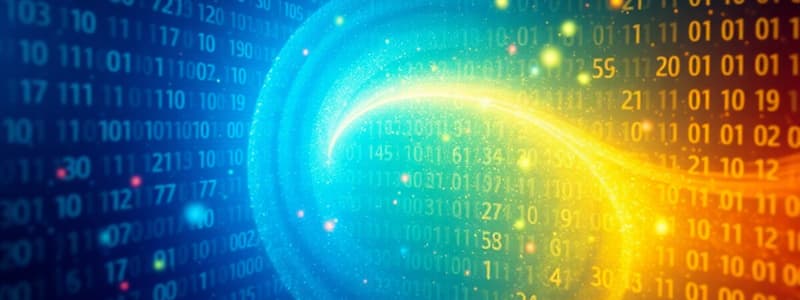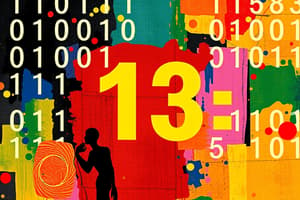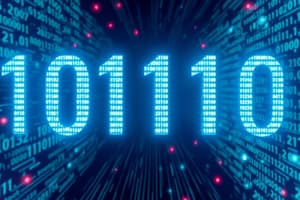Podcast
Questions and Answers
What symbols do modern computers primarily use?
What symbols do modern computers primarily use?
- 0 to 9
- Special characters
- A to Z
- 0 and 1 (correct)
A group of 6 contiguous bits is called a byte.
A group of 6 contiguous bits is called a byte.
False (B)
What is a single '0' or '1' called in computing?
What is a single '0' or '1' called in computing?
bit
A group of 8 contiguous bits, treated as a unit, is called a ______.
A group of 8 contiguous bits, treated as a unit, is called a ______.
What is a group of 4 bits called?
What is a group of 4 bits called?
A bit model is a method of grouping bits without interpretation.
A bit model is a method of grouping bits without interpretation.
What term describes the bit model used to represent only non-negative integers?
What term describes the bit model used to represent only non-negative integers?
The bit model used to represent strictly non-negative integers is ______ binary.
The bit model used to represent strictly non-negative integers is ______ binary.
What deeper understanding does studying bit-models of C data types allow?
What deeper understanding does studying bit-models of C data types allow?
In a positional representation system, the position of a digit does not affect its value.
In a positional representation system, the position of a digit does not affect its value.
In the expression $3 \times 10^2 + 5 \times 10^1 + 7 \times 10^0$, what is the base (or radix) of the number system being used?
In the expression $3 \times 10^2 + 5 \times 10^1 + 7 \times 10^0$, what is the base (or radix) of the number system being used?
In a number system with base r, the number $(d_{n-1}d_{n-2}...d_1d_0)r$ is equal to $d{n-1} \times r^{n-1} + d_{n-2} \times r^{n-2} + ... + d_1 \times r^1$ + ______.
In a number system with base r, the number $(d_{n-1}d_{n-2}...d_1d_0)r$ is equal to $d{n-1} \times r^{n-1} + d_{n-2} \times r^{n-2} + ... + d_1 \times r^1$ + ______.
What is the decimal value of the unsigned binary number 101010₂?
What is the decimal value of the unsigned binary number 101010₂?
When converting a decimal number to binary using the provided algorithm, you stop when the 'bit' value equals 0.
When converting a decimal number to binary using the provided algorithm, you stop when the 'bit' value equals 0.
In the decimal to binary conversion algorithm described, what do the abbreviations MSB and LSB stand for?
In the decimal to binary conversion algorithm described, what do the abbreviations MSB and LSB stand for?
When converting a decimal number to binary using the algorithm provided, if the 'value' is even, the 'bit' is assigned ______.
When converting a decimal number to binary using the algorithm provided, if the 'value' is even, the 'bit' is assigned ______.
According to the example provided, what is the binary representation of the decimal number 123?
According to the example provided, what is the binary representation of the decimal number 123?
Hexadecimal representation uses base 10.
Hexadecimal representation uses base 10.
What prefix is commonly used to identify hexadecimal values?
What prefix is commonly used to identify hexadecimal values?
In hexadecimal, the decimal value 10 is represented by the symbol ______.
In hexadecimal, the decimal value 10 is represented by the symbol ______.
How many bits are required to represent all possible values between 0 and 15?
How many bits are required to represent all possible values between 0 and 15?
When converting binary to hexadecimal, you should create groups of 8 bits starting from the most significant bit.
When converting binary to hexadecimal, you should create groups of 8 bits starting from the most significant bit.
During binary to hexadecimal conversion, after creating groups of 4 bits, what should you do with the 'higit'?
During binary to hexadecimal conversion, after creating groups of 4 bits, what should you do with the 'higit'?
When converting from binary to hexadecimal, you start grouping bits from the ______ (right end).
When converting from binary to hexadecimal, you start grouping bits from the ______ (right end).
What is the hexadecimal representation of the binary number 0111 1111 1111 1000?
What is the hexadecimal representation of the binary number 0111 1111 1111 1000?
In C data types, the size of 'int' is always 4 bytes, regardless of the system architecture.
In C data types, the size of 'int' is always 4 bytes, regardless of the system architecture.
What is the nominal size of pointer data related to, according to the slide?
What is the nominal size of pointer data related to, according to the slide?
A 32-bit word limits virtual address space to ______ GB.
A 32-bit word limits virtual address space to ______ GB.
Which of the following C data types typically occupies 8 bytes of memory?
Which of the following C data types typically occupies 8 bytes of memory?
The C standard guarantees the exact sizes of all data types across all platforms.
The C standard guarantees the exact sizes of all data types across all platforms.
Which ISO C standard defines guaranteed sizes for int32_t and int64_t?
Which ISO C standard defines guaranteed sizes for int32_t and int64_t?
To avoid vagaries of typical sizes ______ defines int32_t, int64_t.
To avoid vagaries of typical sizes ______ defines int32_t, int64_t.
How many bytes do all pointers occupy on a 32-bit system?
How many bytes do all pointers occupy on a 32-bit system?
printf() is a function defined within the C language itself.
printf() is a function defined within the C language itself.
What is the purpose of the % symbol within the format string of a printf() function?
What is the purpose of the % symbol within the format string of a printf() function?
In printf("%2d", dayNum), the %2d specifies that 'dayNum' is an integer with a width of at least ______ digits.
In printf("%2d", dayNum), the %2d specifies that 'dayNum' is an integer with a width of at least ______ digits.
Which format specifier in printf() is used to print a single character?
Which format specifier in printf() is used to print a single character?
In memory addressing, successive word addresses always differ by 4 bytes, regardless of the system architecture.
In memory addressing, successive word addresses always differ by 4 bytes, regardless of the system architecture.
What does each process have when the system provides private address spaces?
What does each process have when the system provides private address spaces?
Addresses specify byte locations, indicating the address of the ______ byte in the word.
Addresses specify byte locations, indicating the address of the ______ byte in the word.
If a variable 'x' has a 4-byte value of 0x01234567 and its address (&x) is 0x100, how would the bytes be arranged in memory in a Big Endian system?
If a variable 'x' has a 4-byte value of 0x01234567 and its address (&x) is 0x100, how would the bytes be arranged in memory in a Big Endian system?
In the little endian system, assuming variable x has a 4-byte address 0x100, find which option is true.
In the little endian system, assuming variable x has a 4-byte address 0x100, find which option is true.
Match the hexadecimal values with their decimal equivalents:
Match the hexadecimal values with their decimal equivalents:
Insanely Difficult: Derive a formula to directly convert any base-10 integer to its hexadecimal representation. Present your formula using precise mathematical notation.
Insanely Difficult: Derive a formula to directly convert any base-10 integer to its hexadecimal representation. Present your formula using precise mathematical notation.
Insanely Difficult: Given a hypothetical computer architecture where memory addresses increment by powers of 3 instead of powers of 2, how would the endianness concept be affected, if at all?
Insanely Difficult: Given a hypothetical computer architecture where memory addresses increment by powers of 3 instead of powers of 2, how would the endianness concept be affected, if at all?
Flashcards
What is a bit?
What is a bit?
A single '0' or '1' in binary code.
What is a byte?
What is a byte?
A group of 8 contiguous bits, processed as a single unit.
What is a Nybble?
What is a Nybble?
A group of 4 bits, which is half of a byte.
What is a bit model?
What is a bit model?
Signup and view all the flashcards
What is unsigned binary?
What is unsigned binary?
Signup and view all the flashcards
What is positional representation?
What is positional representation?
Signup and view all the flashcards
What is radix?
What is radix?
Signup and view all the flashcards
How to convert Decimal to Binary.
How to convert Decimal to Binary.
Signup and view all the flashcards
What is hexadecimal?
What is hexadecimal?
Signup and view all the flashcards
Binary to Hex conversion
Binary to Hex conversion
Signup and view all the flashcards
What is word size?
What is word size?
Signup and view all the flashcards
What is pointer data size?
What is pointer data size?
Signup and view all the flashcards
What is ISO C99?
What is ISO C99?
Signup and view all the flashcards
What is Endianness?
What is Endianness?
Signup and view all the flashcards
What is Big Endian?
What is Big Endian?
Signup and view all the flashcards
What is Little Endian?
What is Little Endian?
Signup and view all the flashcards
Study Notes
- A computer stores all data as numbers.
- Computers use '0' and '1' as their only symbols.
- A bit is a single '0' or '1', short for binary digit.
- A byte is a group of 8 contiguous bits, treated as a unit.
- A nybble is a group of 4 bits.
- Bits are grouped and interpreted using different methods called bit models.
- The unsigned binary bit model represents strictly non-negative integers.
- Studying bit-models of C data types helps understand memory usage.
Placeholder Representation
- Numbers are written using a positional representation system.
- (357)10 is equal to 3 × 102 + 5 × 101 + 7 × 100.
- A number in base r, (dn-1dn-2...d1d0)r, is equal to dn-1 × rn-1 + dn-2 × rn-2 +...+ d1 × r1 + d0 × r0.
- In binary, (bn-1bn-2...b1b0)2 is equal to bn-1 × 2n-1 + bn-2 × 2n-2 + ... + b1 × 2^1 + b0 × 20.
- The unsigned binary number 1010102 is equal to 1 × 25 + 0 × 24 + 1 × 23 + 0 × 22 + 1 × 21 + 0 × 20 which equals 4210.
Conversion: Decimal to Binary
- To convert decimal to binary, start with "value" and "bit" columns.
- For a given value, bit = 0 if value is even, and bit = 1 if value is odd.
- Update value by dividing the number by 2 and taking the floor: value ← ⌊number/2⌋.
- Stop if value = 1, otherwise return to step 1.
- Read the binary representation from bottom (MSB) to top (LSB) in the bit column.
- Example: Converting 12310 results in 11110112.
Hexadecimal Representation
- Modern computers use 32 or 64-bit units (words), which can be simplified using base 16 (hexadecimal).
- Hexadecimal uses 16 symbols, representing values from 0 to 15.
- Hexadecimal symbols 0-9 are the same as in decimal.
- After 9, hexadecimal uses A for 10, B for 11, C for 12, D for 13, E for 14, and F for 15.
- Hexadecimal values are identified with the prefix 0x, like 0xF00D.
Conversion: Binary to Hexadecimal
- To convert binary to hexadecimal, group bits into sets of 4 starting from the least significant bit (LSB).
- Pad the front with zeros if necessary. Example: 0111 1111 1111 1000
- Replace each group of 4 with the corresponding hexadecimal "higit". Example: 0x7 F F 8
- To convert from hexadecimal to binary, replace each "higit" with its group of 4 bits.
- Example: 0xB A D becomes 1011 1010 1101
Practice Problems
- Problems are provided for converting between decimal, hexadecimal, and binary representations.
- Questions prompt thinking without direct conversion for hexadecimal arithmetic.
Basic C Data Types
- Every computer has a word size, the largest number of contiguous bits the ALU handles.
- The word size is the nominal size of pointer data and determines the bits needed for a virtual address.
- A 32-bit word limits virtual address space to 4GB, and a 64-bit word allows 16 Exabytes.
C Data Type Sizes
-
char: 1 byte -
short: 2 bytes -
int: 4 bytes -
long: 4 or 8 bytes -
int32_t: 4 bytes -
int64_t: 8 bytes -
char *: 8 bytes -
float: 4 bytes -
double: 8 bytes -
Allocated sizes are typical but not guaranteed.
-
The C standard guarantees minimum sizes, but actual sizes are implementation-dependent.
-
The ISO C99 standard defines
int32_tandint64_tas guaranteed 4 and 8 bytes, respectively. -
All pointers are 8 bytes on 64-bit systems, and 4 bytes on 32-bit systems.
-
Compilers typically treat
charas signed, but it is not guaranteed by the C standard; use the signed prefix. -
The C standard guarantees lower bounds except for
intN_ttypes and does not guarantee upper bounds.
printf and scanf
printf()is a general-purpose output formatting function.printf()is not defined in C, but included in thestdio.hstandard library.- The first argument is a string of chars to be printed, with
%indicating substitution points. - Example:
printf("%2d\t%f\t%4.2f", dayNum, temperature, cost)specifies how variables should be formatted.%2d:dayNumas an integer with at least 2 digits%f:temperatureas floating point%4.2f:costas floating point with at least 4 characters and 2 decimal places
- Other format specifiers include:
ufor unsignedx,Xforintin hexcfor single charf,g,Gfor floating pointpfor pointer (void *)
Multi-byte Data
- Programs refer to data by address, conceptually a large array of bytes.
- Addresses act as array indices, with pointer variables storing these addresses.
- Systems allocate private address spaces for each process .
- Addresses specify byte locations, particularly the first byte of a word.
- Successive word addresses differ by 8 bytes on 64-bit systems.
Studying That Suits You
Use AI to generate personalized quizzes and flashcards to suit your learning preferences.




